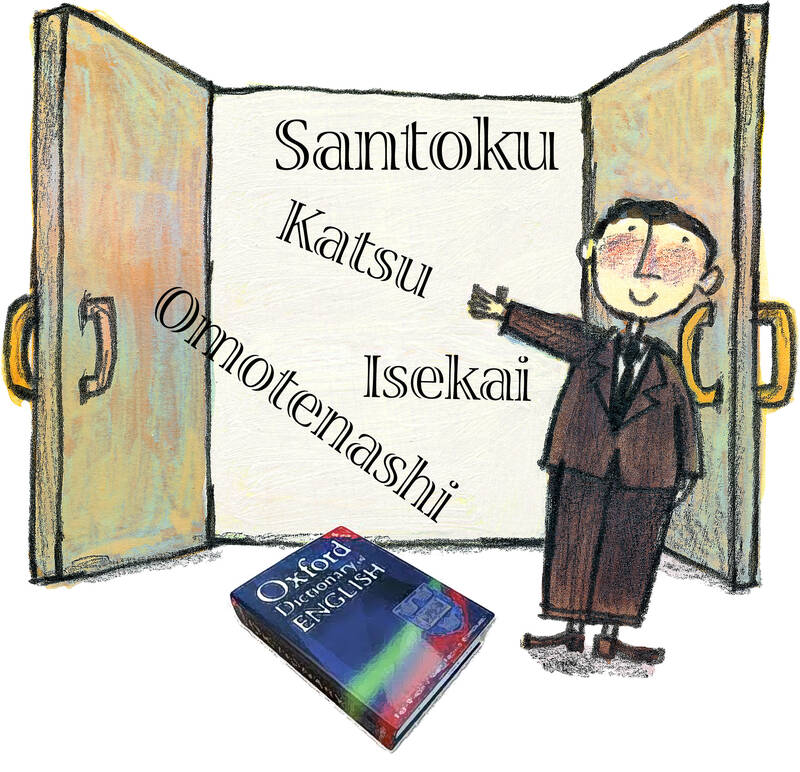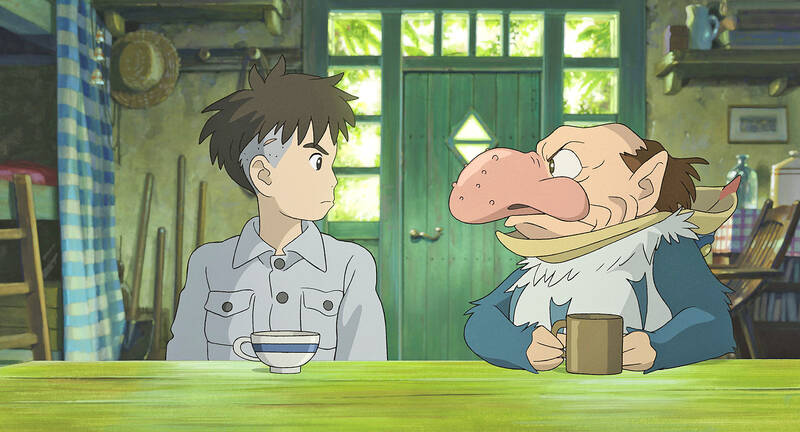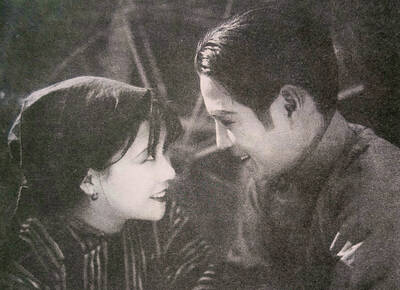Katsu, donburi and onigiri are among 23 Japanese words added to the Oxford English Dictionary (OED) in its latest update.
More than half of the borrowed words relate to food or cooking. Santoku, a knife with a short, flat blade that curves down at the tip, and okonomiyaki, a type of savory pancake, were both added. Okonomiyaki is derived from okonomi, meaning “what you like,” combined with yaki, meaning “to fry, to sear.”
Katsu — a piece of meat, seafood or vegetable, coated with flour, egg and panko breadcrumbs, deep-fried, and cut into strips — is considered a boomerang word, a case of reborrowing: katsu is the shortened form of katsuretsu, which is a borrowing into Japanese of the English word “cutlet.”

GRAPHIC: TT
Donburi, a Japanese dish consisting of rice topped with other ingredients, is also used to describe the bowl in which this dish is served. The culinary use is likely related to the Japanese adverb donburi, meaning “with a splash,” which “could be an allusion to the sound of ingredients being dropped into a bowl,” said Danica Salazar, executive editor of OED’s World Englishes.
Omotenashi, which describes good hospitality, characterized by “thoughtfulness, close attention to detail and the anticipation of a guest’s needs” was also added to the dictionary.
CREATIVE LANGUAGE

Photo: AP
A number of terms related to art also feature in the update. “For centuries, artists from around the world have taken inspiration from Japanese art, and this can be seen in the number of words belonging to the domain of arts and crafts that English has borrowed from Japanese,” said Salazar.
Kintsugi, the Japanese art of repairing broken pottery by joining pieces back together and filling cracks with lacquer dusted with powdered gold, silver or platinum, highlighting the flaws in the mended object, was added. “The word subsequently developed an additional sense indicating an aesthetic or worldview characterized by embracing imperfection and treating healing as an essential part of human experience,” said Salazar.
Isekai, a Japanese genre of fantasy fiction involving a character being transported to or reincarnated in a different, strange, or unfamiliar world, also made the OED. A recent example of the genre is Hayao Miyazaki’s Studio Ghibli film The Boy and the Heron, in which 12-year-old Mahito discovers an abandoned tower, a gateway to a fantastical world.
OED editors worked with researchers from the Tokyo University of Foreign Studies on the new batch of Japanese words. Non-Japanese words added in this quarter’s update include Bible-bashing, ultra-processed and bibliophilia.

Taiwanese chip-making giant Taiwan Semiconductor Manufacturing Co (TSMC) plans to invest a whopping US$100 billion in the US, after US President Donald Trump threatened to slap tariffs on overseas-made chips. TSMC is the world’s biggest maker of the critical technology that has become the lifeblood of the global economy. This week’s announcement takes the total amount TSMC has pledged to invest in the US to US$165 billion, which the company says is the “largest single foreign direct investment in US history.” It follows Trump’s accusations that Taiwan stole the US chip industry and his threats to impose tariffs of up to 100 percent

On a hillside overlooking Taichung are the remains of a village that never was. Half-formed houses abandoned by investors are slowly succumbing to the elements. Empty, save for the occasional explorer. Taiwan is full of these places. Factories, malls, hospitals, amusement parks, breweries, housing — all facing an unplanned but inevitable obsolescence. Urbex, short for urban exploration, is the practice of exploring and often photographing abandoned and derelict buildings. Many urban explorers choose not to disclose the locations of the sites, as a way of preserving the structures and preventing vandalism or looting. For artist and professor at NTNU and Taipei

March 10 to March 16 Although it failed to become popular, March of the Black Cats (烏貓進行曲) was the first Taiwanese record to have “pop song” printed on the label. Released in March 1929 under Eagle Records, a subsidiary of the Japanese-owned Columbia Records, the Hoklo (commonly known as Taiwanese) lyrics followed the traditional seven characters per verse of Taiwanese opera, but the instrumentation was Western, performed by Eagle’s in-house orchestra. The singer was entertainer Chiu-chan (秋蟾). In fact, a cover of a Xiamen folk song by Chiu-chan released around the same time, Plum Widow Missing Her Husband (雪梅思君), enjoyed more

Last week Elbridge Colby, US President Donald Trump’s nominee for under secretary of defense for policy, a key advisory position, said in his Senate confirmation hearing that Taiwan defense spending should be 10 percent of GDP “at least something in that ballpark, really focused on their defense.” He added: “So we need to properly incentivize them.” Much commentary focused on the 10 percent figure, and rightly so. Colby is not wrong in one respect — Taiwan does need to spend more. But the steady escalation in the proportion of GDP from 3 percent to 5 percent to 10 percent that advocates